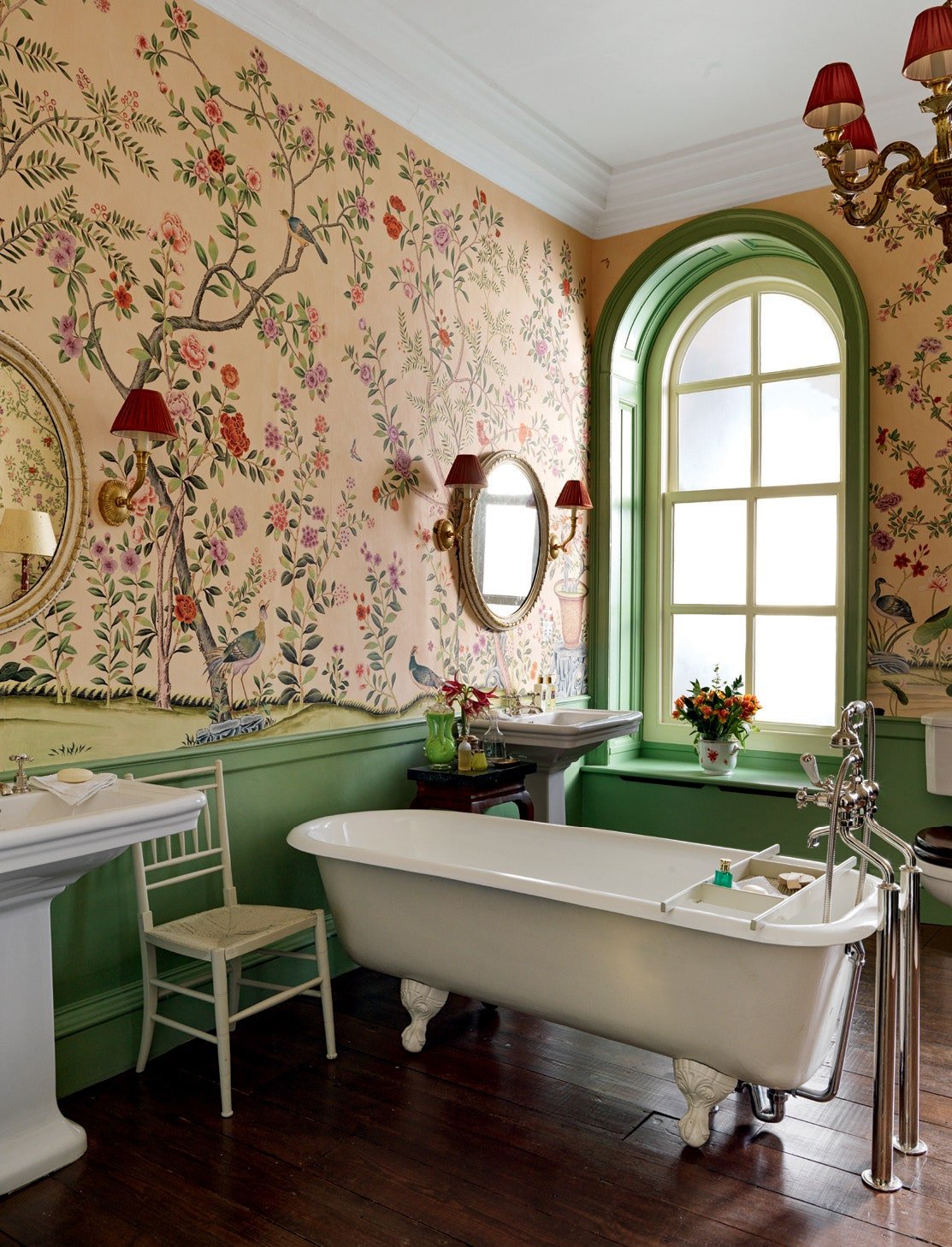Voyages East- The Legacy of Historic Ties
Behind the scenes image from upcoming project ‘Old School Thrills’ by @anouskatamonydesigns
Just a little while to go before our latest full scale project ‘Old School Thrills’, a dashing period home in a gently humming corner of Surrey with a delightfully playful streak, is ready to be professionally photographed. In the meantime, I couldn’t resist a teaser of the Alice in Wonderland-esque powder room and a brief journey through the rich history behind the chinoiserie style wallpaper that bedecks its walls.
Chinoiserie wallpaper first appeared in Europe in the 17th century when it offered a romantic (if largely fictional) peek of a far away, almost mythical, land known primarily through the writings of adventurous European travellers like Marco Polo. Its distinctive look was and remains characterised by intricate, richly coloured designs inspired by traditional Chinese art and culture, featuring motifs such as pagodas, birds, and exotic landscapes. The style soon became incredibly popular in interior design and has become a cornerstone of the classic decorating tradition in Europe and American.
“There is at this place a very fine marble Palace, the rooms of which are all gilt and painted with figures of men and beasts and birds, and with a variety of trees and flowers, all executed with such exquisite art that you regard them with delight and astonishment.“ Marco Polo
Interior- @houghton_hall for @houseandgardenuk (wallpaper inspired by original 18th century chinoiserie papers found in the attic of Houghton Hall)
The origins of chinoiserie wallpaper can be traced back to the 16th century when European traders and diplomats first travelled to China in any significant number. By the 17th century exotic rarities such as porcelain, silk, and lacquerware began regularly making the journey to Europe on ships laden with nutmeg and other official cargo. These objects sparked an interest in Chinese culture and aesthetics, which only grew as ports such as Canton and Macau increased in prominence. Interestingly, the Chinese didn’t use hand painted wall coverings in the style we now know as ‘chinoiserie’, preferring plain papers in solid white, crimson or gold. It’s thought instead that Western merchants admiration for the Chinese trading port practice of pasting over windows with paper illustrated in decorative motifs encouraged the creation of an export market and manufacture of similarly painted papers.
The original designs were laboriously hand-painted on delicate paper before taking the long and occasionally dangerous voyage across the seas to Europe, making them incredibly expensive and only available to the wealthiest members of society. Rare, exclusive, and exotic, they were taken up with gusto by the aristocracy and upper classes as a cosmopolitan status symbol. Indeed, most of the grand country houses and palaces of Europe and Great Britain had at least one room (often a reception room or bedroom) decorated with chinoiserie wallpaper. The demand for the designs grew so high that European manufacturers began to produce their own (often comparatively crude) yet somewhat cheaper and significantly more expedient versions of the lively, briskly coloured papers that were causing such a stir.
‘the upper apartments of my house, which were before handsomely wainscoted’ were now adorned ‘with the richest Chinese and India paper, where all the powers of fancy are exhausted in a thousand fantastic figures of birds, beasts, and fishes, which never had existence’ ‘The World’ newspaper 1753
Victoria and Albert Museum (Portion of chinoiserie wallpaper, circa 1700, hung in Ord House, Berwick-on-Tweed, Northumberland, made in England)
Hand painted chinoiserie mural commissioned for a master bedroom by @anouskatamonydesigns
In the 18th century, advancements in woodblock printing technology allowed for chinoiserie wallpaper to be mass-produced, making it yet more affordable and opening its accessibility to the middle classes. Soon the papers, which continued to be created in a range of intricate designs, were seen in many relatively modest homes. The vogue continued right through to the late 19th century, at which point widespread desire for the style began to wane until the 1920s when Nancy Lancaster’s ‘English Country House Style’ revived interest in chinoiserie papers which are now, perhaps ironically, almost certainly regarded as quintessentially English.
Since then, a renewed love for the style has taken hold, and today chinoiserie papers remains a perennial favourite for many. Just as when they first became popular some 300 years ago they’re a bold choice that can divide opinion but for those that find their scenes enchanting and are attracted to their striking jewelled tones there’s no better way to add spirited sophistication to rooms that require a dash of theatre and mystique!
Asian Women of Achievement Awards 2023
It felt great to be back at one of my favourite annual events with some of the women in my life who are dearest to me.
Always full of inspiring women from different walks of life, one of the highlights of this year's awards was meeting writer and film producer Gurinder Chadha (whose first big hit was 'Bend it Like Beckham') whose work is an example of the power of storytelling to engage and inspire young women to face personal and societal barriers to achieving their potential.
Another was hosting a lively table of 8 up and coming Foreign & Commonwealth Office diplomats and mentees of Vicki Treadell (High Commissioner to Australia), who are full of the ambition and promise the awards started by Pinky Lilani first set out to nurture and celebrate when it started over 20 years ago.










